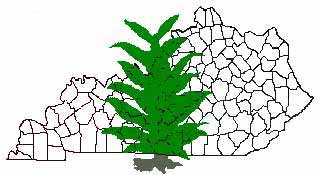

The 2003 Field Crops and Livestock Insecticide Recommendations are available online. You can select crop or livestock pests from appropriate menus. You will get graphics, scouting information, decision guides, and recommended pesticides.
There are links to publications and fact sheets. Newly
registered products will be placed here as appropriate.
Bookmark it and use it often.
See "Insect Management Recommendations" for insecticide recommendations on crops and livestock.

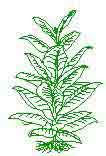 ADVISORY : This is the initial status report for the 2003 season. We have no reports of blue mold activity from Kentucky or
adjacent states, but the disease is active in the prevailing wind routes from the southeast - on cultivated tobacco in the southeastern USA.
Activity has been confirmed in Florida and advisories have been issued for other southern flue-cured production areas, both from the
Florida sources and from Cuba. Burley and dark tobacco growers in the Ohio River Valley are urged to appreciate the risk blue mold in the
southeast may present to transplants being produced in that region and moved to our region.
ADVISORY : This is the initial status report for the 2003 season. We have no reports of blue mold activity from Kentucky or
adjacent states, but the disease is active in the prevailing wind routes from the southeast - on cultivated tobacco in the southeastern USA.
Activity has been confirmed in Florida and advisories have been issued for other southern flue-cured production areas, both from the
Florida sources and from Cuba. Burley and dark tobacco growers in the Ohio River Valley are urged to appreciate the risk blue mold in the
southeast may present to transplants being produced in that region and moved to our region.
General Information: A brief review of the Kentucky Blue Mold Warning System and the "status levels" used is in order as we start the new season.
The Kentucky Blue Mold Warning System is operated by the Plant Pathology Department, University of Kentucky and cooperates with local Extension Tobacco Specialists, County Extension Agents for Agriculture and Natural Resources in Kentucky, and the North American Blue Mold Forecast System at North Carolina State University. Extension Educators from neighboring states served by this educational program also are involved to varying levels. The potential for blue mold developing in a particular crop within the state or region is highly variable based on changing epidemiology about the state within any season. Therefore, since 1980 the Kentucky Blue Mold Warning System has been issuing blue mold status reports to help keep growers informed about the status and probability of blue mold development in the state and region. Three levels of status (based on urgency of action) are used for ranking the potential: 'advisory', 'watch' and 'warning' - from lowest to highest disease potential, respectively. These are assigned by geographic area, so different parts of the state or region are often not under the same us-level may be up-graded to one of higher disease probability, down-graded to one of lesser probability, or canceled.
ADVISORY carries the lowest level of urgency and lowest potential for disease developing in the short term. This is used to maintain grower awareness about the disease in general and its progress outside the state and region. However, some of the most valuable information has been issued as advisories, especially that related to transplant management and movement of diseased transplants.
WATCH is used when conditions are conducive for blue mold development, but usually before blue mold has become active in an area. Under this level, it is presumed that viable spores of the pathogen are arriving in the watch area while crop and weather conditions favor disease development in that area. Under a watch, growers are urged to put preventive controls in place and remain alert for the disease. Because of the nature of the control options available to tobacco growers, controls applied early have the greatest impact on overall blue mold development. Should the disease be found, it is important to promptly report the activity to the local County Extension Office and for the County Extension Offices to promptly collect samples and obtain confirmation from the Plant Disease Diagnostic Labs.
WARNING is issued once blue mold activity has been confirmed in an area, and it remains in effect as long as conditions remain favorable for continued spread and development of the disease. In general, growers should not wait until warnings are issued to begin controls, because great damage can result from the initial round of infection when inoculum load is high or conducive conditions remain protracted. Instead, controls should begin with or prior to the posting of the watch. However, steps should be taken to maintain and improve control programs during warning periods. County Extension offices should be kept advised of the level of disease in the community and success or failure of recommended controls.
As the situation warrants and based on the information available to us, the status levels are adjusted frequently during the growing seasons to reflect the status of blue mold in a region and potential disease threat. Because blue mold normally persists under Kentucky's weather and production conditions once established in a community, warnings often remain in place for much of the season once issued, except under unusual conditions. In contrast, significant adjustment occurs under a watch, because they are frequently expanded to other areas, up-graded to warnings, down-graded to advisories, or canceled.
COUNTY EXTENSION AGENTS are the county blue mold coordinators. It is important that agents keep their clientele informed of the blue mold
status by community for their county. In addition, agents need to keep the state blue mold coordinator informed about the status of blue mold
in their county through initial and regular updates. Reports should include: location of active disease, levels of blue mold activity (including
lesion volume, sporulation level, systemic activity, and crop damage), general crop status and weather conditions, and control progress or
failures. In addition, first cases for each county need to be confirmed to be sure the area is dealing with blue mold and not rumors of blue
mold. Although classic symptoms and signs are easily identified by a trained person, blue mold is not always easily identified because a
wide range of symptoms are associated with blue mold and it can be easily confused with several other diseases and disorders. With the
initial outbreaks, or at other times if warranted, samples of suspected infections should be submitted to the Plant Disease Diagnostic
Laboratories, where identification will occur based on microscopic examination and other assays may be performed. Moreover, the tobacco
trade agreement with the Peoples Republic of China requires that all counties with blue mold be reported and that samples of blue mold be
submitted from each county or marketing areas to the appropriate USDA-APHIS officials for examination.
For the latest blue mold status and other tobacco disease information, check the KY Blue Mold Warning System online.
![]() http://www.uky.edu/Agriculture/kpn/kyblue/kyblue.htm
http://www.uky.edu/Agriculture/kpn/kyblue/kyblue.htm
 An adequate supply of healthy transplants is an important
first step to having a successful tobacco crop. Infectious
diseases can be a limiting factor to successful transplant
production; moreover, diseased transplants can serve as
important sources of pathogen introduction into the field
and community. Recent studies have also demonstrated
that diseased transplants, compared to healthy transplants,
are predisposed to much more severe attacks in the field
from root and stem pathogens. In one study, for example,
black shank activity in a resistant variety was increased
from 24% incidence to 83% when Pythium infected
transplants were set into black shank infested soil.
An adequate supply of healthy transplants is an important
first step to having a successful tobacco crop. Infectious
diseases can be a limiting factor to successful transplant
production; moreover, diseased transplants can serve as
important sources of pathogen introduction into the field
and community. Recent studies have also demonstrated
that diseased transplants, compared to healthy transplants,
are predisposed to much more severe attacks in the field
from root and stem pathogens. In one study, for example,
black shank activity in a resistant variety was increased
from 24% incidence to 83% when Pythium infected
transplants were set into black shank infested soil.
Use of chemicals alone is not the key to disease control in transplant production. Instead, what is needed is a management approach that carefully incorporates cultural and chemical tools. Control of transplant diseases is achieved through rigorous sanitation measures, careful manipulation/management of the production environment, accurate and timely fertilization, insect vector control, avoiding plant stresses, and timely and thorough application of disease controlling pesticides. Both the incidence and severity of diseases in seedling production can be greatly reduced through preventive spray programs. Even where a chemical is labeled for rescue treatments, I urge it be used in a preventive manner. Why? Because a wound remains if infection occurs, and that wound may serve as an infection site for other diseases, especially when it involves the root and lower stem. Moreover, transplants are too valuable, transplant diseases too explosive, and achieving pesticide coverage too difficult to rely on rescue approaches.
Tobacco transplant production in Kentucky occurs in three systems: outdoor-float-beds, greenhouses, and traditional ground beds. The following infectious diseases have given growers problems in the past:
Unfortunately, labeled materials are not available for all diseases or for use in all transplant production systems; therefore, growers will need to read and follow labels carefully to avoid problems. Please be aware that, despite common usage in some communities, there is not labeling to support using the following chemicals in tobacco transplant systems in Kentucky: Actigard*, Acrobat MZ*, Acrobat 50 WP*, Benlate, Banrot, Captan, Chipco, Maxim, Ridomil Gold*, Rovral, Quadris, Tilt, or Terraclor. Some of these products have labeling to directly prohibit use in transplant production systems; some of these products (those followed with *) are labeled for field use, however. Others are not labeled on tobacco at any stage.
Below is a review of the preventive fungicide and bactericide treatments labeled for use in Kentucky for control of tobacco transplant diseases as of March 15, 2003. All these uses have proved effective as labeled. A few others are labeled that have not proven effective in our trials, and they are not included. Please be aware that many of the labeled chemicals will cause stunting or other phytotoxic (phyto) reactions to the tobacco plant even when used as labeled. Some of the production systems in use are so conducive to diseases that these phyto risks appear to be acceptable when weighed against the damage the diseases can cause without controls in place. The labels specifically warn of the risks and also advise on steps that should be taken to minimize those risks. I have recently reviewed these labels and data and believe only the following materials and uses are labeled and effective for the sites and diseases mentioned.
* FERBAM (FERBAM GRANUFLO) is labeled for use in outdoor beds, greenhouses, and float systems in Kentucky, but greenhouse use is not on the label in several other tobacco producing states. This is a very important fungicide for disease control in small seedlings because the risk of phyto is very low, especially at the low rates. It is labeled for prevention of blue mold and Botrytis blight, but will assist in reducing several other fungal diseases. The labeled rate in all transplant production systems (beds, floats, and greenhouses) is 1.5 - 3.0 lbs/100 gallons of water (1 to 3 tablespoons/gallon). Use the lower rates when plants are small and higher rates as plants become larger. Spray preventively twice weekly starting when seedlings have the first true leaf or immediately after plugging with the plug- and- transfer system. Apply as a fine spray to the point of run-off, using 3 gallons of spray material per 1000 sq ft when seedlings are small, increasing gradually to 6 to 12 gallons as plants increase in size and the canopy increases. The label has specific restrictions to avoid contamination of the float-water. We have not observed phyto with this fungicide at these rates, but it does leave a dark residue on the seedlings. Some other formulations of ferbam have national labels for plant beds that allow higher rates of Ferbam to be used, but those labels do not include greenhouse or float beds.
* MANCOZEB (DITHANE DF OR DITHANE DF RAINSHIELD) is another very important preventive fungicide once the plants are large enough to tolerate it. Use it against anthracnose and blue mold, and to suppress damping off diseases caused by Rhizoctonia, Fusarium, and Alternaria. It can be used in all tobacco transplant production systems, but higher rates are needed outdoors. Apply it as a fine spray at high pressure just to the point of run-off, but be careful not to saturate the root zone on small seedlings. For float and greenhouse systems use at 0.5 lbs/100 gallons of water (one teaspoon/gallon). Spray preventively on a 5-7 day schedule starting no earlier than when seedling leaves are about the size of a dime and continue until transplanting to the field. Use 3 gallons of spray material per 1000 sq. ft. while plants are small, but increase gradually to 6 to 12 gallons as plant size and canopy increase. As plants become larger and more tolerant of the material, you need to use sufficient water to wet the base of the stems with run-off to increase the potential for control of damping off and stem rots. Avoid contamination of the float-water and root zone during applications. In outdoor beds, use 1 lb/100 gallons of water (2-3 teaspoons/gallon), applying 3 to 5 gallons per 1000 sq ft of bed.
*Etridiazole (TERRAMASTER 35WP and Terramaster 4EC) is a very important tool for controlling Pythium root rot and damping off in float systems. The float system provides a near ideal environment for Pythium to develop once introduced into the system (especially as temperatures increase), and now labeled controls are available. There are phyto issues involved and it is essential that etridiazole- containing products be uniformly distributed in the float water to achieve control and to minimize phytotoxicity. Two formulations are available Terramaster 35WP and Terramaster 4EC. The EC formulation label has been modified since last year. The EC formulation is much easier to measure and use, but it has higher phyto potential. Both are labeled for use in greenhouse and outdoor float systems, but are NOT labeled for use in any other transplant production systems. In our experiments, etridizaole has provided a very high level of control of Pythium root rot, and it reduces algae levels, but it has not provided adequate control of Phytophthora in our systems. Terramaster 35 WP is labeled at 2 oz/100 gallons of float bed water, but 1 oz/100 gallons gives acceptable control with less phyto potential when disease pressure is low. These applications should be made directly to the float water. Be sure to follow label directions as to making the premix-slurry and thoroughly distribute it in the water. Preventive applications should be made two to three weeks after seeding, or a week after plugging with the plug and transfer system. If additional applications are needed, make a second application no later than eight weeks after seeding.
Terramaster 4EC is labeled as preventive treatment at 0.7 fluid oz/100 gallons of float-bed water. Application should begin no sooner than three weeks after seeding. Supplemental preventative applications can be made at 0.7 fl.oz/100 gallons of float-water 3 weeks after the first application, with a third and final application 2 weeks after the second. Terramaster is also labeled as a rescue (curative) treatment at higher rates of 1.4 fl. oz/100 gallons of float-water. Applications at this higher rate can be used when symptoms first develop but no sooner than three weeks after seeding and with leaves at least one inch in diameter. One additional curative application can be made (if symptoms return) at 1 to 1.4 fl. oz/100 gallons of float- water. There is a limit of 2.8 fl.oz/100 gallons of float-water per bed (crop of plants)/season. No applications can be made later than 8 weeks after seeding.
I urge Pythium controls be used as a preventives rather than letting the fungus damage the root system and then trying to stop it. Wounded roots are prime targets for opportunistic pathogens in the field - black shank, soreshin, and Fusarium root rot. Some regions have reported problems with premature flowering associated with Terramaster applications, but UK scientists have not been able to reproduce those effects in any of the several studies we have conducted, including rates several fold above the labeled rates. Based on some work from other states, we suspect that if plants have been grown under the environmental conditions that induce premature flower, then Terramaster applications may enhance the effect in these predisposed crops. We have observed phyto in the form of reduced roots, white veins, and slower development in every study conducted, including at rates below the effective rates. However, the phyto we have observed in our studies is considered acceptable when compared to the serious damage Pythium is capable of producing. Some phytotoxicity symptoms should be expected with this product. However, it is essential that Terramaster be evenly distributed throughout the float-bed water. The label gives good directions on how to achieve this within the bay, by mixing the product outside the treated bay then delivery of the diluted product uniformly into the bays. In our studies, we have also observed significantly higher phytotoxicity when studies were conducted in water naturally high in pH (above 7.0) than in waters naturally low in pH (less than 6.3).
* STREPTOMYCIN (AGRIMYCIN 17, AGRI-STREP, etc.) is labeled for use in outdoor plant beds. Greenhouse and float bed use is not on the label, however, nor are these sites specifically prohibited on the label. Therefore, growers may elect to use Streptomycin in these systems, but accept that product liability protection may not be provided, because the manufactures have not elected to include greenhouse and float beds on their labels even with our encouragement. The labeled rate for outdoor beds is 100 to 200 ppm (1- 2 teaspoons/ gallon), using 3 to 5 gallons of material per 1000 sq ft of bed. Control of angular leaf spot, wildfire, and blue mold are on the label, but most strains of blue mold are not controlled by this treatment. Streptomycin-resistant strains of the angular leaf spot pathogen are present in Kentucky, and it is not highly effective with bacterial soft rots. Sprays can begin as early as the two-leaf stage and should be repeated weekly until transplanting for control of bacterial leaf spots, such as angular leaf spot. Yellowing and stunting can occur if high rates are used. Efficacy is improved if applications are made under conditions that allow for slow drying.
*MILK (Whole or skim at 5 gals /100 gallons water or dried milk at 5 lbs/100 gallons water per 100 sq. yds. of plants) can be used to reduce the spread of Tobacco Mosaic Virus while handling transplants. Spray plants within 24 hrs of handling them. This treatment has also been used successfully prior to clipping of large plants, but it can be very messy unless the system drys well following the application. It should be combined with washing the hands at 15 minute intervals either in the clean milk solution or a phosphate detergent. This treatment is needed only if TMV susceptible varieties are being used or mixed resistant and susceptible varieties are in the same operation.
* BORDEAUX MIXTURE (1 lb bluestone copper sulfate + 2
lbs fresh hydrated lime mixture per 25 gallons of water) is
labeled for ground beds as a drench to the soil when the
plants have emerged and again 10 days later. This treatment
will control algae and aid in the control of diseases caused
by bacteria (wild fire, angular leaf spot, and blackleg), and
assist in Pythium and blue mold control. Follow the label
EXACTLY as to mixing instructions, because Bordeaux
mixture can be toxic to tobacco seedlings. Constant agitation
is required during application to avoid injury and to achieve
control. Do not apply this mixture to large seedlings. The
main target is actually the soil rather than the tobacco plant.
See "Insect Management Recommendations" for for insecticide recommendations on tobacco and other crops and livestock.
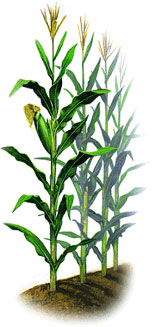
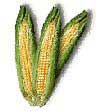 Hot, dry weather prior to, during, and after silking last
summer may have predisposed some corn crops to
development of fumonisins. Several corn samples from a
triangular region in western Kentucky bounded by Grayson
County, Trigg County, and Warren County have been
positive for fumonisins in tests conducted by UK
Regulatory Services. Given the weather conditions that
prevailed last summer, I also would be on the lookout for
fumonisins in scattered crops in the Green River and
Purchase Extension Areas of western Kentucky.
Hot, dry weather prior to, during, and after silking last
summer may have predisposed some corn crops to
development of fumonisins. Several corn samples from a
triangular region in western Kentucky bounded by Grayson
County, Trigg County, and Warren County have been
positive for fumonisins in tests conducted by UK
Regulatory Services. Given the weather conditions that
prevailed last summer, I also would be on the lookout for
fumonisins in scattered crops in the Green River and
Purchase Extension Areas of western Kentucky.
Feeding of Contaminated Grain. Contamination of corn by fumonisins is a concern particularly when feeding to horses, swine, rabbits, and catfish. Recommendations of the U.S. Food and Drug Administration are provided in Table 1. Recognize that there may be many other known or unidentified compounds produced by Fusarium fungi that are toxicologically important. Predicting the effects of utilizing feeds of known analytical composition is still difficult. Do not feed screenings to livestock, especially sensitive species. Fumonisins are often concentrated in these, since concentrations are typically highest in broken and damaged kernels.
Testing for fumonisins. For those situations where the producer or the buyer is interested in testing the grain, rapid detection test kits are available for detecting fumonisins and other mycotoxins. A list of commercially available mycotoxin test kits is provided in Table 2. Be sure the test used is approved by the USDA Grain Inspection, Packers and Stockyard Administration. The UK Grain Quality Testing Lab will also test samples for mycotoxins, but you must specifically request such tests when the sample is submitted. County Extension agents can provide information on submitting a sample to the UK Grain Quality Testing Lab.
For more information on fumonisins, see the Extension
publication ID-121, Fumonisin, Vomitoxin, and Other
Mycotoxins in Corn Produced by Fusarium Fungi, available
from county Extension agents or on the web at
Table 1. Maximum Levels of Fumonisins in Corn and Corn By- Products Recommended by the U.S. Food and Drug Administration (November 9, 2001).
| HUMAN FOODS | |
|---|---|
| Product | Total fumonisins (FB1+FB2+FB3) |
| Degermed dry milled corn products (e.g., flaking grits, corn grits, corn,meal, corn flour with fat content of <2.25%, dry weight basis) | 2 parts per million (ppm) |
| Whole or partially degermed dry milled corn products (e.g., flaking grits, corn grits, corn meal, corn flour with fat content of > 2.25%, dry weight basis) | 4 ppm |
| Dry milled corn bran | 4 ppm |
| Cleaned corn intended for masa production | 4 ppm |
| cleaned corn intended for popcorn | 3 ppm |
| ANIMAL FEEDS | |
| Corn and corn by-products intended for: | Total fumonisins (FB1+FB2+FB3) |
| Equids and Rabbits | 5 ppm (no more than 20% of diet)** |
| Swine and catfish | 20 ppm (no more than 50% of diet)** |
| Breeding ruminants, breeding poultry and breeding mink* | 30 ppm (no more than 50% of diet)** |
| Ruminants > 3 months old being raised for slaughter and mink being raised for pelt production | 60 ppm (no more than 50% of diet)** |
| Poultry being raised for slaughter | 100 ppm (no more than 50% of diet)** |
| All other species or classes of livestock and pet animals | 10 ppm (no more than 50% of diet)** |
Table 2. Commercially Available Test Kits for the Detection of Mycotoxins in Corn*
| Test Kit | Manufacturer | Mycotoxin | Level of Detection (ppm) | Application | Approximate cost per sample | Equipment needed |
|---|---|---|---|---|---|---|
| Agriscreen | Neogen Corp. | DON | 1.0 | Screening | $6.00-7.00 | Starter lab kit, up to $225 |
| Veratox | Neogen Corp. | DON | 0.1 | Quantitative | $6.00-700 | Microwell strip Reader, $1,875. Starter lab kit, up to $970 |
| Veratox | Neogen Corp | Zearalenone | 0.05 | Quantitative | $6.00-7.00 | Microwell strip Reader, $1,875. Starter lab kit, up to $970 |
| Veratox | Neogen Corp. | Fumonisin | 0.2 | Quantitative | $6.00-7.00 | Microwell strip Reader, $1,875. Starter lab kit, up to $970 |
| Mycotest | Romer Labs, Inc. | DON | 0.5 | Quantitative | $16.00 | UV Lamp (long wave) $209 |
| Mycotest | Romer Labs, Inc. | Zearalenone | 0.5 | Quantitative | $16.00 | UV Lamp (long wave) $209 |
| Zearlatest | VICAM | Zearalenone | 0.2-100 | Quantitative | $10.00 | Fluorometer $4,000 |
| Fumonitest | VICAM | Fumonisin | 5-10 | Quantitative | $10.00 | Fluorometer $4,000 |
For more information about corn pests, visit "Insect Management Recommendations".
 The wet weather early last season delayed planting and
allowed cressleaf groundsel (Senecio glabellus) to become a
dominant weed in some no-till stubble fields last spring.
While it is too early to know how bad this weed will be this
season, there is evidence that it is appearing in some fields.
Cressleaf groundsel occurs throughout western Kentucky
in wet areas in pastures but is becoming more evident in no-
till grain fields, particularly in wet seasons. It is thought to
be a biennial, however, some references indicate it is an
annual. Butterweed or ragwort are other common names
associated with this species.
The wet weather early last season delayed planting and
allowed cressleaf groundsel (Senecio glabellus) to become a
dominant weed in some no-till stubble fields last spring.
While it is too early to know how bad this weed will be this
season, there is evidence that it is appearing in some fields.
Cressleaf groundsel occurs throughout western Kentucky
in wet areas in pastures but is becoming more evident in no-
till grain fields, particularly in wet seasons. It is thought to
be a biennial, however, some references indicate it is an
annual. Butterweed or ragwort are other common names
associated with this species.
Cressleaf groundsel grows 1 to 3 feet in height and is characterized by its hollow succulent stems without hairs and yellow daisy-like flowers that occur in clusters at tips of slender stems. Plants bloom April through May. Individual leaves have lobes pinnately arranged along the midrib with a large lobed segment at the leaf tip.
Golden ragwort (Senecio aureus), common groundsel (Senecio vulgaris), round-leaf ragwort (Senecio obovatus), small's ragwort (Senecio smallii) are related to cressleaf groundsel and can occur in Kentucky, but are probably less evident in no-till fields in the western part of the state. They are sometimes confused with mustards, but the daisy-like flower is much different than the 4 petals of mustard flowers.
CONTROL: The importance in controlling this weed may in some instances be a matter of debate The fact that cressleaf groundsel matures and dies back in mid spring indicates that it is probably more unsightly than a competitive problem in no-till corn and soybeans. Those who want to control groundsels may observe that postemergence applications of 2,4-D are generally NOT effective. However, examples of herbicides registered for managing groundsels are listed below:
For no-till Corn: Banvel, glyphosate products, Gramoxone Max. Growers who used fall-applied Princep may have had success in managing cressleaf groundsel.
For no-till Soybean: Backdraft, glyphosate products, Gramoxone Max, Pursuit.
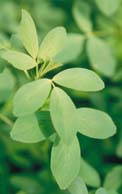
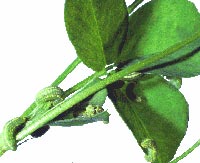 The alfalfa weevil is the key pest of the first cutting from
established alfalfa fields. Feeding damage can appear early
in the spring following mild winters but is generally later
following cold winters that keep adult weevils from laying
many eggs until spring.
The alfalfa weevil is the key pest of the first cutting from
established alfalfa fields. Feeding damage can appear early
in the spring following mild winters but is generally later
following cold winters that keep adult weevils from laying
many eggs until spring.
Degree day accumulations in south and west Kentucky will
reach levels in late March that trigger the first field check for
tip feeding damage by weevil larvae. While it is a good idea
to check fields that had weevil problems last year, the
majority of weevil activity will probably be later in the
spring. This will give alfalfa a chance to grow and be less
susceptible to feeding damage.
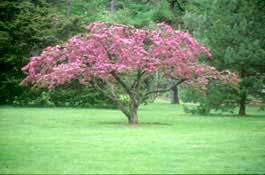
If this year becomes one of those bad apple scab years for
flowering crabapples we can probably look back on this past
weekend as the beginning. Based on data provided from
instruments located at the University of Kentucky
Horticultural Research Farm, a prolonged wetting period
(44 hours) began on Thursday last week and ended
Saturday morning. With air temperatures averaging near 53
degrees F, heavy apple scab infections would have occurred
on exposed susceptible flowering crabapple leaves. In our
experience, fungal inoculum from old leaves would be
available now. In Lexington, flowering crabapples were at
1/2 inch green tip or more and were likely infected,
however most apples here were still at the bud swell (silver
tip) stage and would not have had much exposed
susceptible leaf tissue. If sterol inhibitor fungicides such as
Nova or Rubigan were applied right away, these early
fungal infections might still be eradicated.
Flowering crabapples grow well in Kentucky and are favorites where small trees are desired in the landscape. If new trees are to be planted this spring, landscapers and homeowners will want to be sure to plant scab-resistant cultivars. Ongoing disease evaluations done at Ohio State University by Jim Chatfield and Eric Draper, have provided valuable information on the new scab-resistant flowering crabapples.
The following lists summarize the reaction of flowering crabapple cultivars to apple scab disease. Flowering crabapple culitvars that are immune or resistant to scab show little or no scab and are recommended for planting in Kentucky.
Flowering crabapples that are susceptible or very susceptible are not recommended for planting in Kentucky.

 Many bugs are beginning to appear "mysteriously" inside
homes and businesses. Most have either been ladybugs,
cluster flies/face flies, yellowjacket or paper wasp (queens),
stink bugs, or leaf-footed (seed) bugs.
Many bugs are beginning to appear "mysteriously" inside
homes and businesses. Most have either been ladybugs,
cluster flies/face flies, yellowjacket or paper wasp (queens),
stink bugs, or leaf-footed (seed) bugs.
Where Did They Come From?
These critters actually gained entry last fall through cracks
and openings, and spent the winter hibernating in attics,
soffits, wall voids, window/door casings, and similar
protected areas. With the onset of warmer weather, the
insects have again become active and are emerging from
their overwintering sites. As they attempt to escape to their
natural habitat outdoors, some inadvertently disperse
inward into living areas, emerging from beneath
baseboards, behind window and door frames, from within
sash-cord openings, and around light fixtures and
ventilators. Since many insects are attracted to light, they are
often seen around windows and lighting fixtures.
What Can Be Done Now?
This is a temporary annoyance that will run it's course as
the weather continues to warm. Ladybugs, cluster/face
flies, and stink/leaf-footed bugs characteristically do not
bite, sting, or carry diseases, nor do they infest food,
clothing or wood. They do not breed (reproduce) inside
buildings and generally will not survive indoors more than
a few days. Yellowjackets or paper wasps spotted indoors
this time of year are overwintering queens, attempting to
get outdoors to initiate their spring nests. The emerging
queens are not normally aggressive, but will sting if
mishandled.
The easiest way to dispose of these overwintering insects found indoors is with a vacuum cleaner, broom or fly swatter. Insecticides are not generally recommended unless the temporary annoyance can no longer be tolerated. Aerosol- type foggers containing pyrethrins may be of some benefit in severely infested attics, but will provide no residual control of insects that have not yet emerged from cracks and other protected locations. Large numbers of lady beetles, flies or wasps accumulating in ceiling light fixtures would suggest the attic as a possible treatment area. Insect light traps supplied by pest control firms can also be installed in such areas, although they too may be of limited benefit. Aerosol sprays or foggers are not recommended for treatment of bedrooms, kitchens, or other living areas within the home. The effect of such treatment would be negligible against any insects which have not yet emerged from wall voids and other hidden locations. Flies or ladybugs spotted on walls, windows, and exposed surfaces can just as easily be removed with a vacuum or fly swatter.
What Can Be Done To Prevent Future Problems?
It is hard to predict whether structures experiencing
problems this year will have problems next year. Since most
of these pests seek out overwintering sites in late-
summer/fall, cracks and other openings can be sealed as a
preventive measure. Use a good quality silicone or silicone-
latex caulk to seal cracks around windows, doors, siding,
fascia boards, utility pipes, wires, and other openings.
Repair damaged window screens and install insect
screening behind attic vents
(See Entfact-641, How to Pest-Proof Your Home).
While sealing and weatherstripping can help limit pest entry, the approach is time_consuming and often impractical. There are countless cracks and crevices under and around eaves, siding, vents, etc., where overwintering insects can enter. On multi-story buildings, sealing becomes especially difficult. Households or businesses that do not wish to chance a reoccurring problem with overwintering flies or lady beetles next season may want to enlist the services of a knowledgeable pest control firm. Many companies offer strategically placed insecticide treatments to the building exterior, which helps prevent pest sightings indoors. Long-lasting, rapid-knockdown formulations of pyrethroid insecticides can be professionally applied around eaves, attic vents, windows, siding, and other likely points of entry. The key is to apply the treatments in late September or early October, before pests enter buildings to overwinter. Such treatments would be ineffective at this point (late winter), since the overwintered pests are already indoors.
People have varying levels of tolerance toward insects in their homes. Hospitals, food processors, and other "high-clean" establishments have zero tolerance for contaminants of any kind. Vacuuming, fly swatters and pest proofing, supplemented by client education, are the preferred methods of dealing with overwintering insects infesting structures in Kentucky. Insecticides should be used only when the situation warrants, and prescribed as indicated above.
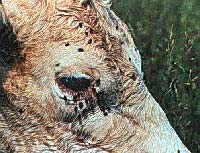 There are several systems that can be put in place so that
cattle can treat themselves with insecticides for horn fly and
face fly control, generally in an effective and economical
manner. Dust bags and backrubbers can be made or
purchased. In addition, there are spray systems that can be
incorporated into mineral stations or triggered as animals
pass through gaps in fences between pastures.
Self-applicators must be placed where all animals will use
them daily. The devices must be sturdy enough to hold up
to frequent use and situated so they are easy to re-charge.
Dust bags need to be hung so that the animal must butt it
with its head to pass by. This way, the face and backline are
treated. Dust bags can provide excellent horn fly control and
good face fly control if they are placed correctly.
Backrubbers provide good coverage of the back and sides.
This is fine for horn fly control but "fly-flips" must be added
to provide coverage to the face for face fly control.
Backrubbers are often set in loafing areas and use by some
animals may be very irregular.
There are several systems that can be put in place so that
cattle can treat themselves with insecticides for horn fly and
face fly control, generally in an effective and economical
manner. Dust bags and backrubbers can be made or
purchased. In addition, there are spray systems that can be
incorporated into mineral stations or triggered as animals
pass through gaps in fences between pastures.
Self-applicators must be placed where all animals will use
them daily. The devices must be sturdy enough to hold up
to frequent use and situated so they are easy to re-charge.
Dust bags need to be hung so that the animal must butt it
with its head to pass by. This way, the face and backline are
treated. Dust bags can provide excellent horn fly control and
good face fly control if they are placed correctly.
Backrubbers provide good coverage of the back and sides.
This is fine for horn fly control but "fly-flips" must be added
to provide coverage to the face for face fly control.
Backrubbers are often set in loafing areas and use by some
animals may be very irregular.
Several sprayer designs incorporate compressed air or a solar collector and electric pump to deliver a measured spray dose as the animal visits a mineral station. These can be set to deliver the product to the face and backline as the animal feeds.
Self-applicators need to be checked regularly to mack sure
that they are charged and functioning properly. Watch the
animals use the devices to see if a change in placement will
improve application or ensure that all animals get treated.
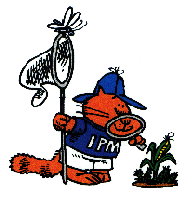
UKREC-Princeton, KY, March 13 - 24| Black cutworm
| 0
| UKREC-Princeton, KY, March 20 - 24 | True armyworm
| 4
| | ||
NOTE: Trade names are used to simplify the information presented in this newsletter. No endorsement by the Cooperative Extension Service is intended, nor is criticism implied of similar products that are not named.
Lee Townsend
Extension Entomologist